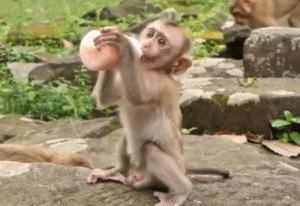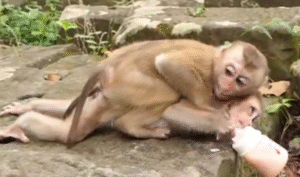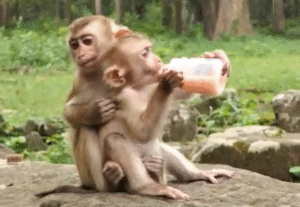It was a humid morning deep in the forest outskirts of Chiang Rai when something strange caught the eye of a group of hikers. As they followed a dirt trail littered with fallen leaves and broken branches, they heard an unfamiliar whimpering—soft, broken cries that didn’t sound like any wild animal they had encountered before. One of the hikers, Jen, stopped and raised her hand. Everyone froze.
There, beneath the twisted roots of an old fig tree, they spotted a heartbreaking sight that none of them could have imagined.
A tiny baby monkey. All alone. Shivering. Clutching something with his small, trembling fingers.
It was a half-empty baby bottle.




His fur was damp, sticking to his skin from the morning dew. His large, teary eyes blinked slowly as if he had been waiting. Waiting for someone—anyone—to come. The bottle, which still had a little milk left inside, was dirty but clearly meant for him. It was clear now: this baby monkey hadn’t just wandered into the forest. He had been left there. Alone. Possibly abandoned.
The hikers cautiously approached. But instead of running, the little monkey inched forward—his bottle still in hand—making soft, helpless sounds. He wasn’t afraid of humans. He didn’t know to be. And that’s what hurt the most. He looked hopeful. As if he had been taught that people bring safety, love… and food.
Jen knelt down and extended her hand. The baby monkey, weak and staggering, slowly crawled into her lap. He didn’t fight. He didn’t resist. He just clung. As if he knew this might be his only chance.
The group quickly wrapped the tiny creature in a sweater and gave him clean water. One of them called local wildlife rescue, and within 30 minutes, a team was on its way. The rescue workers arrived with a heated blanket and infant milk formula. As soon as they cradled the baby and gently pulled the bottle from his grasp, he whimpered—but once the warm formula touched his lips, he drank like his life depended on it.
He was no more than a few weeks old. His tiny fingers couldn’t even wrap around the full bottle properly. His legs were thin, his stomach slightly bloated, and signs of dehydration were clear. But what stood out most was the bottle—a clear sign that someone had cared for him, and then walked away.
Was he stolen and dumped? Was his mother killed? Was he a pet someone no longer wanted?
Nobody knew the full story. But the way he held onto that bottle, even in the middle of the jungle, told everyone watching one thing loud and clear: this baby didn’t choose to be alone.
The rescue team brought him to a rehabilitation center where he was given the name Lucky—because that’s exactly what he was. Had the hikers taken a different trail, or had they come an hour later, Lucky might not have survived. Rescuers said the bottle likely sustained him for a few hours, maybe longer, but his body was already showing signs of fading.
Over the next few days, Lucky was watched closely. He struggled with digestion, cried for comfort, and sometimes wouldn’t eat unless someone held him close. His rescuers took turns giving him warm milk, tucking him into soft blankets, and even playing lullaby sounds during sleep time. Slowly, he responded.
But emotionally, Lucky’s scars ran deep.
One rescuer, Anna, shared through tears:
“Every time we step away, he cries. He looks for the bottle constantly. It’s like it’s his only memory of comfort. This baby has already experienced abandonment… and he’s barely a month old.”
Soon, Lucky’s story made it onto local news stations. Then regional. Then viral on social media.
People were outraged. Heartbroken. Thousands of messages poured in:
- “Who could do this to a baby monkey?!”
- “Thank God the hikers found him in time.”
- “I want to donate or adopt him—how can I help?”
Donations flowed into the wildlife center, enough to build a new nursery enclosure and fund three more rescue missions. Lucky’s tiny tragedy awakened something powerful in the hearts of people who had never even seen a monkey up close.
One artist even painted Lucky—clutching his bottle, eyes full of sadness—against a jungle background. The image was shared 500,000 times with the hashtag #SaveLuckyNow.
And slowly, Lucky grew stronger.
He began to crawl, then climb. He started exploring toys and even made a small friend—a rescued baby gibbon named Coco. While Lucky still carried emotional fragility, his spirit began to shine. He would squeak with excitement at feeding time and cling to volunteers with surprising strength. The bottle, once a symbol of his abandonment, was slowly replaced with love and care.
Lucky’s future remains uncertain. Can he ever return to the wild? Will he be able to form bonds with his own kind again? Those are questions time will answer. But one thing is for sure:
Lucky’s life matters. And his story is now a voice for every abandoned baby animal left behind.
Because when you see a baby monkey holding a milk bottle, alone in the forest, you don’t turn away. You help. You tell the world. And together, we fight to make sure no baby is ever abandoned again. 💔🐒🍼